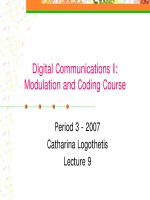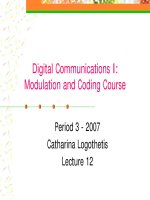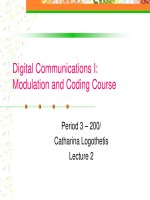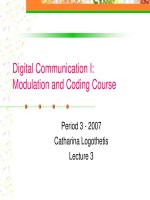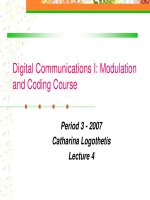Modulation and coding course- lecture 1
Bạn đang xem bản rút gọn của tài liệu. Xem và tải ngay bản đầy đủ của tài liệu tại đây (411.32 KB, 25 trang )
Digital Communication I:
Modulation and Coding Course
Period 3 - 2007
Catharina Logothetis
Lecture 1
Lecture 1 2
Course information
Scope of the course
Digital Communication systems
Practical information
Course material
Schedule
Staff
Grading
More information on:
/>
Introduction to digital communication systems
Lecture 1 3
Scope of the course
Communication is a process by which information
is exchanged between individuals through a
common system of symbols, signs, or behavior
Communication systems are reliable, economical
and efficient means of communications
Public switched telephone network (PSTN), mobile
telephone communication (GSM, 3G, ...), broadcast
radio or television, navigation systems, ...
The course is aiming at introducing fundamental
issues in designing
a (digital) communication
system
Lecture 1 4
Scope of the course ...
Example of a (digital) communication systems:
Cellular wireless communication systems
Base Station (BS)
User Equipment (UE)
UE
UE
UE
BS
Lecture 1 5
Scope of the course ...
General structure of a communication systems
Formatter
Source
encoder
Channel
encoder
Modulator
Formatter
Source
decoder
Channel
decoder
Demodulator
Transmitter
Receiver
SOURCE
Info.
Transmitter
Transmitted
signal
Received
signal
Receiver
Received
info.
Noise
Channel
Source User
Lecture 1 6
Scope of the course …
Learning fundamental issues in designing a digital
communication system (DCS):
Utilized techniques
Formatting and source coding
Modulation (Baseband and bandpass signaling)
Channel coding
Equalization
Synchronization
....
Design goals
Trade-offs between various parameters
Lecture 1 7
Practical information
Course material
Course text book:
“Digital communications: Fundamentals and Applications” by
Bernard Sklar,Prentice Hall, 2001, ISBN: 0-13-084788-7
Additional recommended books:
“Communication systems engineering”, by John G. Proakis and
Masoud Salehi, Prentice Hall, 2002, 2
nd
edition, ISBN: 0-13-
095007-6
“Introduction to digital communications”, by Michael B. Pursley,
Pearson, Prentice Hall, 2005, International edition, ISBN: 0-13-
123392-0
”Digital communications”, by Ian A. Glover and Peter M. Grant,
Pearson, Prentice Hall, 2004, 2
nd
edition, ISBN: 0-13-089399-4
Material accessible from course homepage:
News
Lecture slides (.ppt, pdf)
Laboratory syllabus (Lab. PM)
Set of exercises and formulae
Old exams
Lecture 1 8
Schedule
13 lectures:
from week 5 to week 8
10 tutorials:
week 5 to week 8
1 mandatory laboratory work:
Week 9
Final written exam on 12th of March 2007 kl
9.00-14.00.
Lecture 1 9
Staff
Course responsible and lecturer and giving
tutorials:
Catharina Logothetis
Office: Hus 7 (våning 6), Ångström
Tel.: 018-471 3068
Email:
Lecture 1 10
Today, we are going to talk about:
What are the features of a digital communication
system?
Why “digital” instead of “analog”?
What do we need to know before taking off
toward designing a DCS?
Classification of signals
Random process
Autocorrelation
Power and energy spectral densities
Noise in communication systems
Signal transmission through linear systems
Bandwidth of signal


